Basil microgreens are taking the culinary and health world by storm, and for good reason. These tiny powerhouses pack three times more nutrients than their mature counterparts, delivering an intense burst of flavor that elevates any dish. Whether you’re a seasoned gardener or just starting your indoor growing journey, basil microgreens offer an accessible way to add fresh, nutrient-dense greens to your diet year-round.
In this comprehensive guide, we’ll explore everything you need to know about growing basil microgreens at home, from selecting the right seeds to harvesting your first crop. You’ll discover the incredible health benefits, learn troubleshooting techniques, and get practical tips that ensure your success with these remarkable sprouted greens.
Nutrition Packed
Vitamins A, C, E, K, B-complex plus essential minerals
Easy Growing
Perfect for beginners with simple hydroponic methods
Health Benefits
Anti-inflammatory & antibacterial properties
Cost Effective
Seeds cost $20-50/lb, yield multiple harvests
Visual Growing Journey
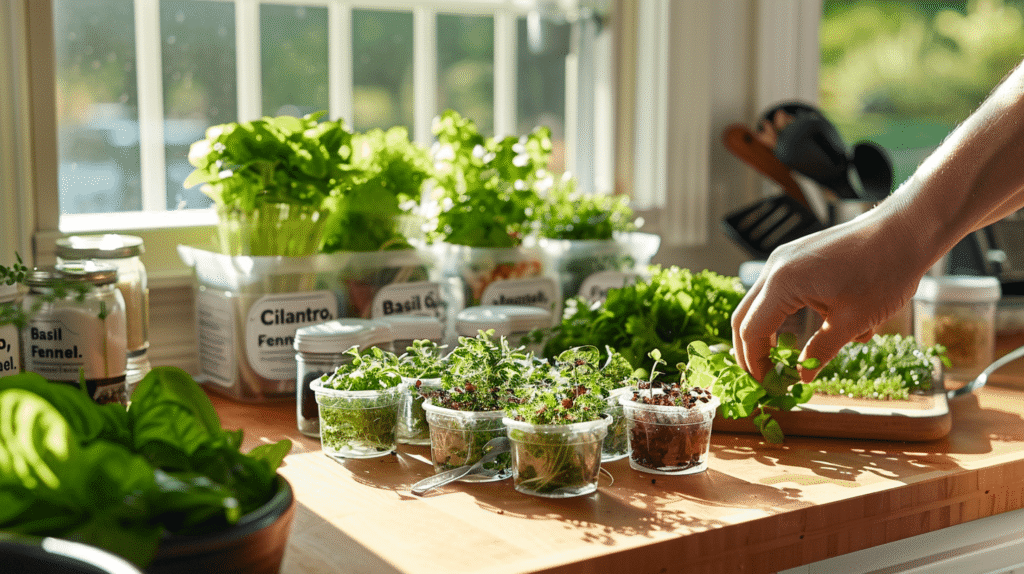
Setup Stage
Modern kitchen setup with proper lighting and ventilation for optimal basil microgreens growth.
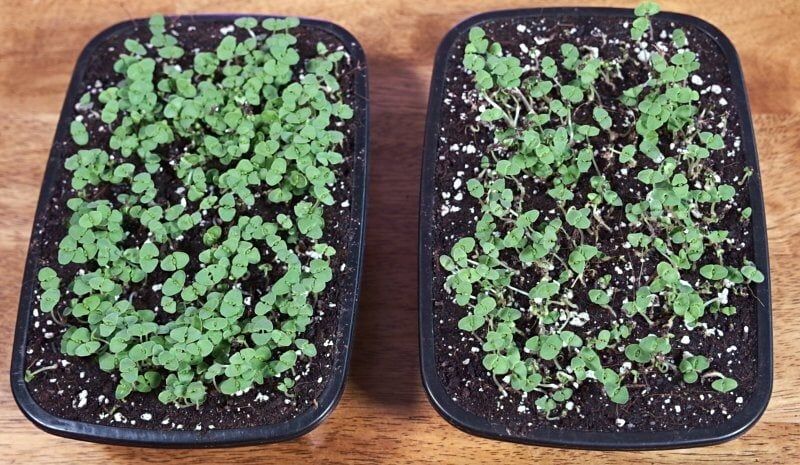
Day 11 Growth
Basil microgreens showing healthy development with first true leaves emerging.
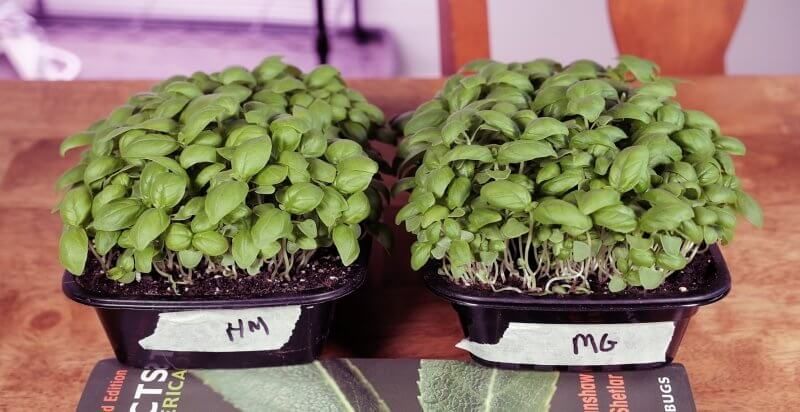
Day 19 Harvest
Mature basil microgreens ready for harvest with fully developed leaves and intense flavor.
Complete Growing Guide for Basil Microgreens
Step-by-Step Growing Instructions
1. Seed Selection and Preparation
Choose high-quality basil microgreen seeds from reputable suppliers. Genovese basil is the most popular variety for microgreens, offering excellent flavor and growth characteristics. You’ll need approximately 10-15 grams of seeds per standard 10″×20″ tray.
💡 Pro Tip: Basil seeds are mucilaginous (sticky when wet), so handle them gently and avoid over-soaking.
2. Growing Medium Setup
Basil microgreens thrive in various growing mediums. For hydroponic growth, use coconut coir, rockwool, or hemp mats. For soil-based growing, use a high-quality potting mix with good drainage. The growing medium should be moist but not waterlogged.
- Coconut coir: Excellent water retention and drainage
- Rockwool: Sterile and consistent moisture distribution
- Hemp mats: Sustainable and pH-neutral option
- Potting mix: Traditional soil-based approach
3. Sowing and Germination
Spread seeds evenly across your prepared growing medium. Basil microgreens don’t require pre-soaking due to their mucilaginous nature. Cover with a humidity dome or another tray to maintain moisture and create darkness for germination.
Germination Timeline: 2-3 days at 65-75°F (18-24°C)
4. Light and Environmental Conditions
Once germination occurs, remove the cover and provide 12-16 hours of light daily. LED grow lights work excellently for basil microgreens. Maintain temperature between 65-75°F with good air circulation to prevent mold and fungal issues.
Lighting Requirements
- 12-16 hours daily
- LED grow lights preferred
- 6-12 inches from plants
Environmental Conditions
- Temperature: 65-75°F
- Humidity: 40-60%
- Good air circulation
5. Watering and Maintenance
Water basil microgreens from the bottom using a tray system to prevent disturbing the delicate roots. Keep the growing medium consistently moist but never waterlogged. Check daily and adjust watering as needed.
⚠️ Warning: Overwatering is the #1 cause of failure with basil microgreens. They’re susceptible to dampening-off disease.
Nutrition Facts & Health Benefits
Nutritional Powerhouse
Basil microgreens are incredibly nutrient-dense, containing three times more nutrients than mature basil plants. This concentration makes them an excellent addition to any health-conscious diet.
Vitamins
- Vitamin A (Beta-carotene)
- Vitamin C (Ascorbic acid)
- Vitamin E (Tocopherol)
- Vitamin K (Phylloquinone)
- B-complex vitamins
Minerals
- Iron (Essential for blood)
- Calcium (Bone health)
- Potassium (Heart function)
- Magnesium (Muscle function)
- Zinc (Immune system)
Special Compounds
- Eugenol: Anti-inflammatory properties
- Antioxidants: Combat oxidative stress
- Essential oils: Aromatic and therapeutic
Health Benefits
Anti-Inflammatory Properties
The eugenol compound in basil microgreens helps reduce inflammation in the body, potentially supporting joint health and reducing chronic inflammation markers.
Antibacterial Effects
Research shows that basil microgreens possess natural antibacterial properties that may help combat harmful bacteria and support digestive health.
Antioxidant Power
Rich in antioxidants, these sprouted greens help protect cells from damage caused by free radicals, potentially reducing the risk of chronic diseases.
Digestive Support
The concentrated nutrients in basil microgreens support healthy digestion and may help improve nutrient absorption from other foods.
Immune System Boost
High levels of vitamin C and other immune-supporting compounds help strengthen the body’s natural defense mechanisms.
Daily Consumption: It’s safe and beneficial to eat basil microgreens daily as part of a balanced diet.
Seed Information & Pricing Guide
Seed Quantities
| 1 oz | ~19,000 seeds |
| 4 oz | ~76,000 seeds |
| 1 lb | ~280,000 seeds |
| 5 lb | ~1,400,000 seeds |
Price Ranges
| 1 oz packet | $5-10 |
| 4 oz packet | $12-20 |
| 1 lb bulk | $25-45 |
| 5 lb bulk | $100-200 |
Cost Analysis
Seeds per tray: 10-15g
Cost per tray: $2-4
Harvest yield: 6-8 oz
Market value: $20-35
Profit margin: 80-90%
ROI: Excellent for home use
What to Look For
- High germination rates (85%+)
- Organic certification when possible
- Fresh packaging dates
- Specific microgreen varieties
Harvesting & Storage Guide
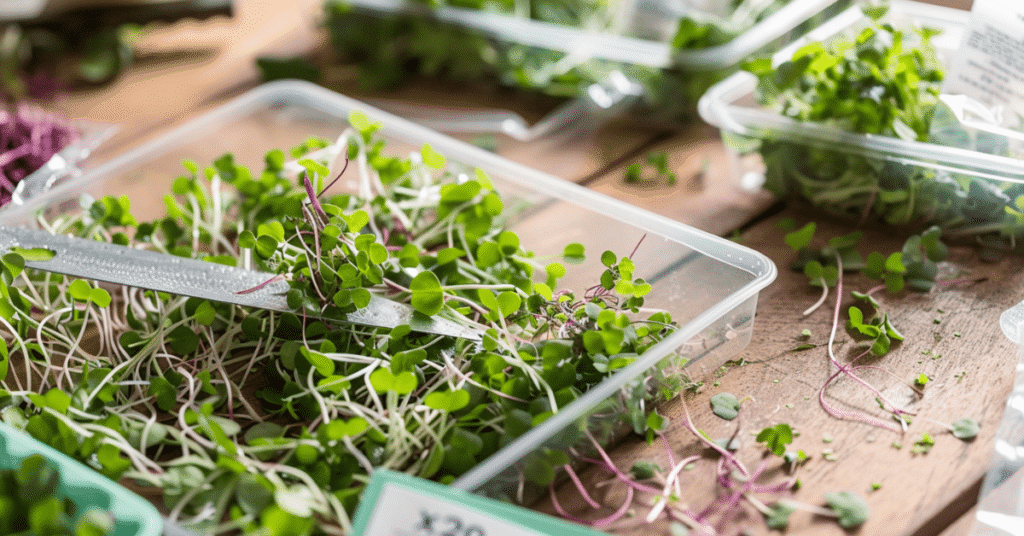
Harvesting Techniques
When to Harvest
Basil microgreens are ready to harvest 16-25 days after sowing, when they develop their first set of true leaves beyond the cotyledons.
- Height: 1-2 inches tall
- Appearance: Vibrant green color
- Aroma: Strong basil scent
Harvesting Method
Use clean, sharp scissors to cut the microgreens about 1/4 inch above the growing medium. Harvest in the morning for the best flavor and longest shelf life.
💡 Cut only what you need – fresh microgreens have the best flavor and nutrition.
Post-Harvest Care
Gently rinse harvested microgreens in cool water and pat dry with paper towels. Remove any seed hulls or damaged leaves for the best presentation.
Storage Solutions
Short-Term Storage (1-3 days)
- Store in refrigerator at 35-40°F
- Use airtight containers or sealed bags
- Add a damp paper towel for moisture
- Keep away from ethylene-producing fruits
Extended Storage (3-7 days)
- Use specialized microgreen storage containers
- Maintain 90-95% humidity
- Check daily for any signs of decay
- Remove any wilted or damaged leaves
Living Storage
For maximum freshness, consider “living storage” – keeping microgreens in their growing trays and harvesting as needed.
🌱 This method maintains peak nutrition and flavor for up to 2 weeks.
Storage Tips
- Never store wet microgreens
- Avoid plastic bags without ventilation
- Check stored microgreens daily
- Use within 5-7 days for best quality
Troubleshooting Common Issues
Common Problems
Slow Growth
Basil microgreens are naturally slower-growing than other varieties.
Solutions: Ensure adequate temperature (65-75°F), sufficient light (12-16 hours), and proper ventilation.
Mold Growth
White fuzzy growth on growing medium or stems.
Solutions: Improve air circulation, reduce humidity, avoid overwatering, and ensure proper drainage.
Leggy Growth
Tall, thin stems with sparse leaf development.
Solutions: Increase light intensity, reduce temperature slightly, and ensure proper seed density.
Poor Germination
Low percentage of seeds sprouting.
Solutions: Check seed freshness, maintain consistent moisture, and ensure proper temperature during germination.
Prevention & Solutions
Optimal Environment
- Temperature: 65-75°F (18-24°C)
- Humidity: 40-60%
- Air circulation: Gentle fan
- Light: 12-16 hours LED
Watering Best Practices
- Bottom watering only
- Maintain consistent moisture
- Avoid water on leaves
- Use filtered or distilled water
Sanitation Protocol
- Clean all equipment between uses
- Use hydrogen peroxide solution
- Maintain clean growing area
- Remove failed crops promptly
Success Indicators
- Uniform germination within 2-3 days
- Steady growth rate
- Vibrant green color
- Strong basil aroma
- No signs of mold or disease
Culinary Uses & Kitchen Applications
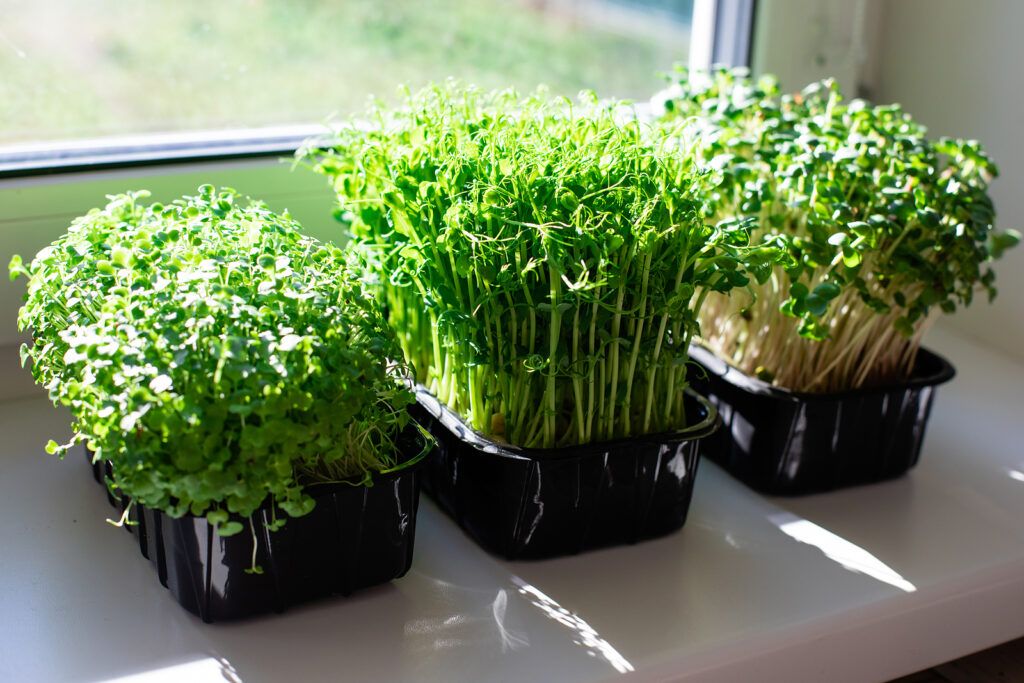
Flavor Profile
Basil microgreens deliver an intense, concentrated basil flavor that’s significantly stronger than mature basil leaves. The taste is sweet, slightly peppery, with aromatic herbal notes that can elevate any dish.
Flavor Characteristics
- Intensity: 3-4x stronger than mature basil
- Aroma: Highly fragrant and aromatic
- Texture: Tender and delicate
- Color: Vibrant green with purple varieties available
Culinary Applications
- Fresh garnish for Italian dishes
- Pesto and sauce ingredient
- Salad enhancer
- Pizza and pasta topping
- Cocktail garnish
Recipe Ideas
Microgreen Pesto
Replace traditional basil with basil microgreens for an intensely flavored pesto.
- 2 cups basil microgreens
- 1/3 cup pine nuts
- 2 cloves garlic
- 1/2 cup olive oil
- 1/2 cup Parmesan cheese
Gourmet Salad Mix
Combine with other microgreens for a nutrient-dense salad.
- Mix with arugula microgreens
- Add radish microgreens for spice
- Include pea shoots for sweetness
- Dress with lemon vinaigrette
Infused Oils & Vinegars
Create gourmet condiments using basil microgreens.
- Basil microgreen olive oil
- Flavored vinegars
- Compound butters
- Herb salts
Serving Suggestions
- Use as a finishing touch – add after cooking
- Pair with tomatoes and mozzarella
- Excellent in Mediterranean cuisine
- Perfect for upscale presentation
Advanced Growing Techniques
Hydroponic Systems
Growing basil microgreens hydroponically offers several advantages including faster growth, higher yields, and better control over nutrition. Here’s how to set up a successful hydroponic system:
Deep Water Culture (DWC)
Roots grow directly in nutrient solution with air pumps providing oxygen.
- Best for larger operations
- Requires air pumps and air stones
- Fastest growth rates
- Higher initial setup cost
Ebb and Flow Systems
Growing medium is periodically flooded with nutrient solution.
- Good for beginners
- Uses growing medium like rockwool
- Automated watering cycles
- Reduced risk of over-watering
Nutrient Film Technique (NFT)
Thin film of nutrient solution flows over roots continuously.
- Water efficient
- Requires proper slope (1:40)
- Good for commercial production
- Minimal growing medium needed
LED Lighting Optimization
Proper lighting is crucial for basil microgreens success. LED lights offer the best control and efficiency for indoor growing:
Light Spectrum
- Blue (400-500nm): Promotes compact growth
- Red (600-700nm): Encourages photosynthesis
- Full spectrum: Best overall results
- Purple LEDs: Cost-effective option
Light Intensity
- PPFD: 200-400 μmol/m²/s
- Distance: 6-12 inches from plants
- Duration: 12-16 hours daily
- Timer: Automated controls recommended
Energy Efficiency Tips
- Use LED fixtures with high efficacy (>2.5 μmol/J)
- Install reflective materials around growing area
- Adjust light height as plants grow
- Monitor plants for light stress symptoms
Recommended LED Setup
- 40W LED per 10×20 tray
- Full spectrum or 3:1 red:blue ratio
- Adjustable height mounting system
- Timer controller for consistency
Seasonal Growing Considerations
Summer Growing
Challenges: High temperatures, increased humidity, pest pressure
- Increase ventilation and air circulation
- Consider basement or cooler area growing
- Monitor for mold more frequently
- Adjust watering schedule for higher evaporation
Winter Growing
Advantages: Controlled environment, consistent temperatures, lower pest pressure
- Ensure adequate heating (65-75°F)
- Increase light duration due to shorter days
- Monitor humidity levels (can drop in heated spaces)
- Take advantage of peak growing season
Year-Round Success Tips
Temperature Control
Maintain 65-75°F consistently
Daily Monitoring
Check moisture, growth, and health
Environmental Adjustment
Adapt to seasonal changes
Frequently Asked Questions
How long do basil microgreens take to grow?
Basil microgreens typically take 16-25 days to grow from seed to harvest. They germinate in 2-3 days and are ready when they develop their first set of true leaves beyond the cotyledons.
Growth timeline: Germination (2-3 days) → First leaves (7-10 days) → Harvest ready (16-25 days)
What are the health benefits of basil microgreens?
Basil microgreens are packed with vitamins A, C, E, K, and B-complex, plus essential minerals like iron, calcium, and potassium. They have 3x more nutrients than mature basil and offer anti-inflammatory and antibacterial properties.
- Eugenol: Anti-inflammatory compound
- Antioxidants: Combat free radicals
- Essential oils: Antimicrobial properties
How much do basil microgreen seeds cost?
Basil microgreen seeds typically cost $20-50 per pound, with approximately 280,000-300,000 seeds per pound. Smaller quantities range from $5-15 for 1-4 oz packages.
Cost breakdown: 1 oz ($5-10) | 4 oz ($12-20) | 1 lb ($25-45) | 5 lb ($100-200)
Can I grow basil microgreens hydroponically?
Yes, basil microgreens grow excellently in hydroponic systems. They thrive in coconut coir, rockwool, or other soilless growing mediums with proper moisture and light conditions.
- Best mediums: Coconut coir, rockwool, hemp mats
- Nutrient requirements: Balanced hydroponic solution
- Advantages: Faster growth, higher yields, better control
What do basil microgreens taste like?
Basil microgreens have an intense, concentrated basil flavor – much stronger than mature basil leaves. They offer a sweet, slightly peppery taste with aromatic herbal notes that can transform any dish.
Flavor profile: 3-4x stronger than mature basil, sweet, peppery, highly aromatic
Are basil microgreens safe to eat daily?
Yes, basil microgreens are safe to eat daily and highly beneficial due to their nutrient density. They provide essential vitamins, minerals, and antioxidants that support overall health and can be incorporated into various meals.
Daily serving: 1-2 tablespoons provides significant nutritional benefits without adverse effects
Why are my basil microgreens growing slowly?
Basil microgreens grow slowly due to environmental factors like low temperature, insufficient light, poor air circulation, or overwatering. They need consistent 65-75°F temperatures and 12-16 hours of light daily.
- Temperature: Maintain 65-75°F consistently
- Light: 12-16 hours of LED lighting
- Airflow: Gentle circulation prevents stagnation
- Moisture: Consistent but not waterlogged
Start Your Basil Microgreens Journey Today
Growing basil microgreens at home is one of the most rewarding ways to add fresh, nutrient-dense greens to your diet. With their incredible health benefits, intense flavor, and relatively simple growing requirements, these sprouted powerhouses are perfect for both beginners and experienced gardeners.
Nutritious
3x more nutrients than mature basil
Easy to Grow
Perfect for indoor hydroponic systems
Versatile
Enhance any dish with intense flavor
Ready to start growing? Get your seeds today and experience the difference fresh, homegrown basil microgreens can make!


